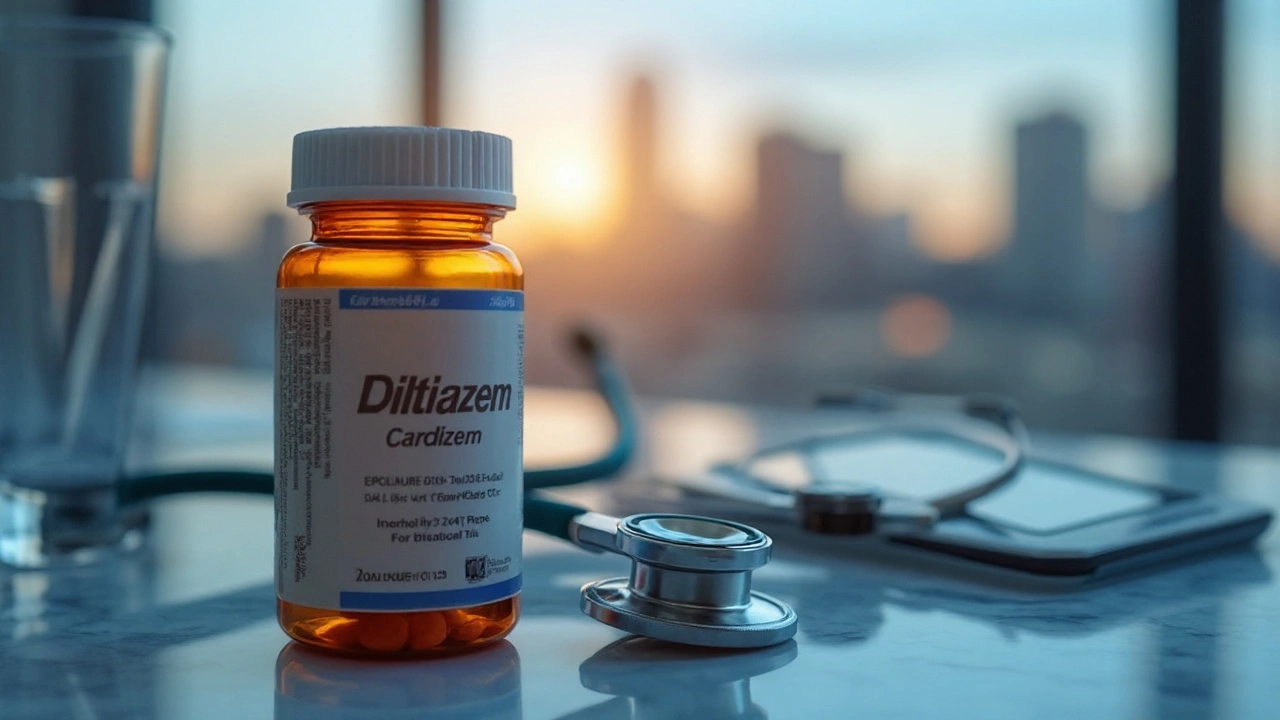Cardizem (Diltiazem) Guide: Uses, Dosage, Side Effects & FAQs
 Sep, 20 2025
Sep, 20 2025
TL;DR - Quick Takeaways
- Cardizem is the brand name for diltiazem, a calcium‑channel blocker used for angina and certain heart rhythm problems.
- Typical adult dose ranges from 120‑360mg per day, split into 1‑3 doses depending on the formulation.
- Most common side effects: headache, dizziness, swelling (edema) and flushing.
- Never combine with strong CYP3A4 inhibitors (e.g., grapefruit juice, certain antibiotics) without doctor approval.
- Call your doctor if you notice severe bradycardia, sudden weight gain, or unexplained fainting.
What Is Cardizem and How Does It Work?
Cardizem is the commercial name for diltiazem, a medication that belongs to the calcium‑channel blocker family. In plain terms, it relaxes the muscles of your blood vessels and the heart muscle by blocking calcium from entering cells. Less calcium means less contraction, which lowers blood pressure and reduces the heart’s workload.
Doctors prescribe it for three main reasons:
- Relief of stable angina (chest pain caused by reduced blood flow to the heart).
- Control of certain types of supraventricular tachycardia (rapid heart rhythms that start above the ventricles).
- Management of high blood pressure when other drugs aren’t enough or cause side effects.
The drug comes in several forms - immediate‑release tablets, extended‑release capsules, and a once‑daily extended‑release tablet (Cardizem CD). Each formulation has a different dosing schedule, so it’s crucial to follow the prescription label exactly.
How to Take Cardizem - Dosage Basics
Dosage depends on the condition you’re treating, the formulation, and your personal health profile (age, liver function, other meds). Below is a handy reference for typical adult dosing. Always start at the lowest effective dose and let your doctor adjust based on response and any side effects.
| Formulation | Typical Indication | Usual Adult Dose | Frequency |
|---|---|---|---|
| Immediate‑Release Tablet (30mg) | Angina, hypertension | 30-180mg | Every 6-8hours |
| Extended‑Release Capsule (120mg) | Angina, hypertension | 120-240mg | Once daily (or divided twice daily) |
| Extended‑Release Tablet - Cardizem CD (180‑240mg) | Angina, hypertension, SVT | 180‑360mg | Once daily |
Key points to remember:
- Swallow tablets whole - don’t crush or chew extended‑release forms.
- If you miss a dose, take it as soon as you remember unless it’s nearly time for the next dose; then skip the missed one.
- Never double‑dose to make up for a forgotten pill.
- Alcohol can enhance diltiazem’s blood‑pressure‑lowering effect, so limit intake.

Common Side Effects and When to Worry
Most people tolerate Cardizem well, but a few side effects are frequent enough to expect. Below is a quick rundown of what you might feel and when it warrants a call to your healthcare provider.
- Headache - mild to moderate; often improves after a few days.
- Dizziness or light‑headedness - especially when standing up quickly (orthostatic hypotension).
- Flushing or a warm sensation - common with the immediate‑release form.
- Peripheral edema (ankle swelling) - more common with higher doses; monitor weight.
- Bradycardia (slow heart rate) - if heart rate drops below 50bpm, seek medical advice.
- Gastrointestinal upset - nausea or constipation.
Red‑flag symptoms that need immediate attention:
- Severe chest pain that doesn’t improve with rest.
- Sudden, unexplained fainting or near‑fainting.
- Rapid, irregular heartbeat (palpitations) that feel different from usual.
- Swelling of the face, lips, or tongue (possible allergic reaction).
Remember, everyone’s body reacts differently. If you’re unsure about a symptom, it’s better to call your doctor.
Drug Interactions - What Not to Mix With Cardizem
Cardizem is metabolized mainly by the liver enzyme CYP3A4. Anything that blocks or boosts this enzyme can change the drug’s levels in your blood, sometimes dramatically.
Common culprits include:
- Strong CYP3A4 inhibitors - e.g., clarithromycin, itraconazole, grapefruit juice.
- Other calcium‑channel blockers (verapamil) - can cause excessive slowing of the heart.
- Beta‑blockers - may increase the risk of bradycardia.
- Digoxin - diltiazem can raise digoxin levels, raising toxicity risk.
- Statins metabolized by CYP3A4 (atorvastatin, simvastatin) - higher risk of muscle damage.
Always give your pharmacist a complete medication list, including over‑the‑counter products and supplements. If you’re prescribed a new drug, ask whether dose adjustments for Cardizem will be needed.
Frequently Asked Questions
These are the questions people most often type into search engines after hearing the name Cardizem.
"Patients should never stop taking cardiovascular medicines abruptly without medical guidance; sudden withdrawal can trigger rebound hypertension or arrhythmias." - American Heart Association
- Can I take Cardizem during pregnancy? It’s classified as Category C (risk cannot be ruled out). Only use if the potential benefit justifies the risk, and always under obstetric supervision.
- Is Cardizem safe for seniors? Older adults often have slower drug metabolism, so doctors may start at the low end of the dose range and monitor kidney and liver function closely.
- Will Cardizem affect my ability to drive? Dizziness is a possible side effect, especially when you first start or after dose changes. Test how you feel before getting behind the wheel.
- How long does it take to feel better? For angina, many patients notice relief within a few days. For blood‑pressure control, steady improvement is usually seen after 1‑2 weeks.
- Can I eat grapefruit while on Cardizem? No. Grapefruit blocks CYP3A4 and can raise diltiazem levels, increasing side‑effect risk.

Next Steps - Using Cardizem Safely
If you’ve just been prescribed Cardizem, here’s a quick action plan to keep things smooth:
- Write down the exact brand, dose, and timing. Set a daily alarm if you’re on multiple doses.
- Review your current medication list with a pharmacist. Flag any CYP3A4 inhibitors.
- Measure your blood pressure and pulse daily for the first two weeks. Note any trends.
- Track side effects in a simple notebook - date, symptom, severity. Bring it to follow‑up appointments.
- Schedule a check‑in with your doctor after 4‑6 weeks to evaluate effectiveness and adjust dose if needed.
Sticking to this routine helps you get the most benefit from Cardizem while minimizing surprises. If anything feels off, don’t wait - call your healthcare team.

Raghav Suri
September 20, 2025 AT 22:52First off, make sure you actually read the label – those extended‑release capsules are not meant to be crushed, so don’t mistake them for a quick fix. Keep a daily alarm; missing a dose and then doubling up is a fast track to bradycardia. Grapefruit juice is a classic trap – it hijacks CYP3A4 and can push diltiazem levels sky‑high, leading to dizziness or even fainting. If you’re on a statin that the liver also metabolizes, flag it with your pharmacist, because you don’t want muscle damage on top of anything else. And finally, track your blood pressure and pulse for the first two weeks – a sudden drop below 50 bpm or a spike in ankle swelling is a sign to call the doc right away.
Freddy Torres
September 22, 2025 AT 16:32Remember, consistency beats occasional heroics when it comes to heart meds.
Andrew McKinnon
September 24, 2025 AT 10:12Wow, another “just take it as prescribed” reminder – as if we’re all sitting around a kitchen table sipping herbal tea while the pharmacist hands us a cocktail of calcium‑channel blockers. Sure, don’t mix with grapefruit, but did anyone mention the cascade of CYP3A4 interactions you’ll see if you’re also on a macrolide antibiotic? The jitters you feel aren’t just “side effects,” they’re your body screaming “I’m being over‑modulated!” and the occasional edema is just the price you pay for “relaxing your vessels.” If you ever wonder why you’re light‑headed, blame the synergy of diltiazem plus any beta‑blocker you might be on – it’s a perfect storm of pharmacodynamic overload.
Dean Gill
September 26, 2025 AT 03:52Let’s unpack the practical steps you should follow once Cardizem lands on your medicine cabinet. First, write down the exact brand name, dosage, and timing on a sticky note; visual cues are indispensable for medication adherence. Second, set a recurring alarm on your phone – the human brain is notoriously lazy when it comes to remembering multiple daily doses. Third, keep a simple log: date, time, and any symptoms you notice, whether it’s a mild headache or a creeping swelling in the ankles. Fourth, avoid any strong CYP3A4 inhibitors; that includes not just grapefruit juice but also certain antifungals and macrolide antibiotics – the list is longer than most people realize. Fifth, if you’re on a statin that shares the same metabolic pathway, ask your pharmacist whether a dose adjustment is necessary to prevent myopathy. Sixth, measure your blood pressure and pulse each morning for at least two weeks; trends matter more than isolated readings. Seventh, if you notice your heart rate dropping below 50 beats per minute, don’t wait for a blackout – contact your clinician immediately. Eighth, watch out for signs of fluid retention – a sudden weight gain of two or more pounds in a day, or noticeable swelling in the feet, could indicate the drug’s vasodilatory effects are tipping over into edema. Ninth, be mindful of alcohol consumption; even moderate drinking can amplify diltiazem’s hypotensive impact. Tenth, if you ever feel dizzy upon standing, that orthostatic drop is a red flag that your blood pressure is too low and you might need a dosage tweak. Eleventh, keep all your other medications, including over‑the‑counter and supplements, on a single list and share it with your prescriber – hidden interactions are a common source of adverse events. Twelfth, schedule a follow‑up appointment within 4‑6 weeks of starting therapy; that’s the window when you’ll get a clear picture of efficacy and tolerability. Thirteenth, discuss any persistent side effects with your doctor – sometimes a slight dose reduction can preserve benefits while alleviating discomfort. Fourteenth, never stop taking Cardizem abruptly; sudden withdrawal can cause rebound hypertension or arrhythmias, a scenario you definitely want to avoid. Finally, trust your instincts – if something feels off, a quick call to your healthcare team is far better than playing the guessing game at home.
Royberto Spencer
September 27, 2025 AT 21:32In the grand scheme, medicating without due diligence borders on ethical negligence; we owe ourselves the courtesy of informed vigilance. It is not merely a prescription but a covenant between patient and practitioner that must be honored with reverence for the drug’s power. Therefore, one must approach Cardizem with both humility and responsibility, lest complacency become the silent architect of avoidable harm.